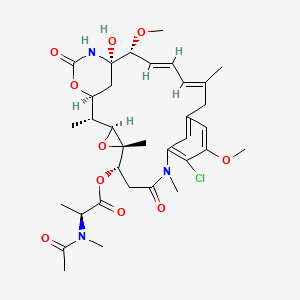| MeSH term | MeSH ID | Detail |
|---|---|---|
| Asthenia | D001247 | 5 associated lipids |
| Body Weight | D001835 | 333 associated lipids |
| Brain Diseases | D001927 | 27 associated lipids |
| Breast Neoplasms | D001943 | 24 associated lipids |
| Bronchial Spasm | D001986 | 18 associated lipids |
| Colonic Neoplasms | D003110 | 161 associated lipids |
| Hyperplasia | D006965 | 34 associated lipids |
| Hypopharyngeal Neoplasms | D007012 | 1 associated lipids |
| Leukemia | D007938 | 74 associated lipids |
| Leukemia P388 | D007941 | 43 associated lipids |
MAYTANSINE
MAYTANSINE is a lipid of Polyketides (PK) class. Maytansine is associated with abnormalities such as Myelosuppression and BOSLEY-SALIH-ALORAINY SYNDROME. The involved functions are known as Mutation, Agent, Polymerization, Cell Cycle Arrest and Drug Kinetics. Maytansine often locates in Cytoplasm, Hepatic, Lysosomes, Cell surface and Microtubules. The associated genes with MAYTANSINE are ABCB1 gene, HM13 gene, CNN1 gene, CYP2C8 gene and CYP2D6 gene. The related lipids are Valerates. The related experimental models are Xenograft Model.
Cross Reference
Introduction
To understand associated biological information of MAYTANSINE, we collected biological information of abnormalities, associated pathways, cellular/molecular locations, biological functions, related genes/proteins, lipids and common seen animal/experimental models with organized paragraphs from literatures.
What diseases are associated with MAYTANSINE?
MAYTANSINE is suspected in Myelosuppression, BOSLEY-SALIH-ALORAINY SYNDROME and other diseases in descending order of the highest number of associated sentences.
Related references are mostly published in these journals:
| Disease | Cross reference | Weighted score | Related literature |
|---|
Possible diseases from mapped MeSH terms on references
We collected disease MeSH terms mapped to the references associated with MAYTANSINE
PubChem Associated disorders and diseases
What pathways are associated with MAYTANSINE
There are no associated biomedical information in the current reference collection.
PubChem Biomolecular Interactions and Pathways
Link to PubChem Biomolecular Interactions and PathwaysWhat cellular locations are associated with MAYTANSINE?
Visualization in cellular structure
Associated locations are in red color. Not associated locations are in black.
Related references are published most in these journals:
| Location | Cross reference | Weighted score | Related literatures |
|---|
What functions are associated with MAYTANSINE?
Related references are published most in these journals:
| Function | Cross reference | Weighted score | Related literatures |
|---|
What lipids are associated with MAYTANSINE?
Related references are published most in these journals:
| Lipid concept | Cross reference | Weighted score | Related literatures |
|---|
What genes are associated with MAYTANSINE?
Related references are published most in these journals:
| Gene | Cross reference | Weighted score | Related literatures |
|---|
What common seen animal models are associated with MAYTANSINE?
Xenograft Model
Xenograft Model are used in the study 'IMGN853, a Folate Receptor-α (FRα)-Targeting Antibody-Drug Conjugate, Exhibits Potent Targeted Antitumor Activity against FRα-Expressing Tumors.' (Ab O et al., 2015).
Related references are published most in these journals:
| Model | Cross reference | Weighted score | Related literatures |
|---|
NCBI Entrez Crosslinks
All references with MAYTANSINE
Download all related citations| Authors | Title | Published | Journal | PubMed Link |
|---|---|---|---|---|
| Perrino E et al. | Curative properties of noninternalizing antibody-drug conjugates based on maytansinoids. | 2014 | Cancer Res. | pmid:24520075 |
| RÃos-Luci C et al. | Resistance to the Antibody-Drug Conjugate T-DM1 Is Based in a Reduction in Lysosomal Proteolytic Activity. | 2017 | Cancer Res. | pmid:28687619 |
| Kovtun YV et al. | Antibody-maytansinoid conjugates designed to bypass multidrug resistance. | 2010 | Cancer Res. | pmid:20197459 |
| Kovtun YV et al. | Antibody-drug conjugates designed to eradicate tumors with homogeneous and heterogeneous expression of the target antigen. | 2006 | Cancer Res. | pmid:16540673 |
| Erickson HK et al. | Antibody-maytansinoid conjugates are activated in targeted cancer cells by lysosomal degradation and linker-dependent intracellular processing. | 2006 | Cancer Res. | pmid:16618769 |
| Yalowich JC | Effects of microtubule inhibitors on etoposide accumulation and DNA damage in human K562 cells in vitro. | 1987 | Cancer Res. | pmid:2879622 |
| Tsuruo T et al. | Rhizoxin, a macrocyclic lactone antibiotic, as a new antitumor agent against human and murine tumor cells and their vincristine-resistant sublines. | 1986 | Cancer Res. | pmid:3753552 |
| Fellous A et al. | Effects of Tau and MAP2 on the interaction of maytansine with tubulin: inhibitory effect of maytansine on vinblastine-induced aggregation of tubulin. | 1985 | Cancer Res. | pmid:3928146 |
| Wang H et al. | Aberrant intracellular metabolism of T-DM1 confers T-DM1 resistance in human epidermal growth factor receptor 2-positive gastric cancer cells. | 2017 | Cancer Sci. | pmid:28388007 |
| Ogitani Y et al. | Bystander killing effect of DS-8201a, a novel anti-human epidermal growth factor receptor 2 antibody-drug conjugate, in tumors with human epidermal growth factor receptor 2 heterogeneity. | 2016 | Cancer Sci. | pmid:27166974 |
